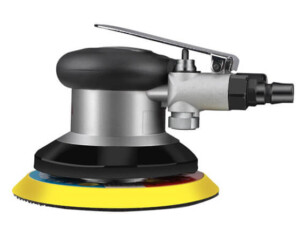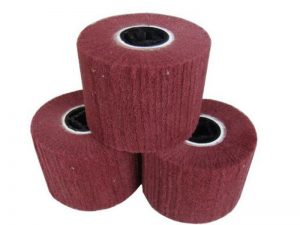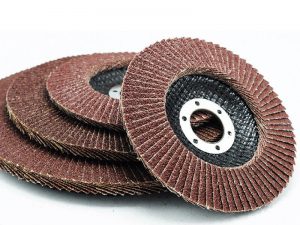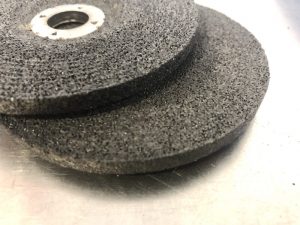Manual grinding and polishing, is still in the main polishing stage, although the robot’s grinding and polishing has slowly embarked on the formal, but it must be said that the robot polishing first one is the footprint, requires a large amount of area to place the robotic hand and supporting machinery and equipment, and for small and medium-sized factories, the site area is limited, the location of 1 robotic hand is temporarily used, may be the location of several workers, so the general The factories with small space do not adopt intelligent grinding.
Second is a small machine equipment, for small factories, in addition to hand grinding is this type of small sanding machine, most of the sanding will be completed by the machine tool, and then use the hand sanding some parts of the machine can not be completed. This is for small parts or parts. If the finished product is irregular welding scar grinding, in addition to intelligent robots, can only be hand-ground, such as stainless steel water storage tanks, automobile skeletons and so on.
What are the processes and corresponding tools for manual welding channel grinding and its polishing?
Of course, our main material is welded steel pipe, the main purpose is to give it to remove traces of welding, so that you look smooth and smooth. The next step is to polish the pipe to achieve the mirror-like finish we see in the stores.
Weld scars are usually removed with an angle grinder, and then the materials vary. We’ll list a few.
The first kind of louvers: louvers are traditional pages of sandpaper cut into small pieces of sandpaper, and then glued together into the arrangement of the abrasive sheet material.
With the angle grinder, high-speed rotation of the grinding blade, can quickly remove the welding scar, but its sharp grinding performance, in the hands of inexperienced workers, it is easy to cause excessive grinding of the product body, injury to the body, so the novice does not recommend the use of, or the welding scar grinding requirements of the deeper case of the best choice.
Blades are suitable for: metal and non-metallic hard to teach hard materials, such as stainless steel, copper, iron, cemented carbide, etc.
The second type of nylon sheet: nylon sheet of the overall material, somewhat similar to fiber compounds, the surface is not very hard, grinding particles coated on the surface, so that it does not lose its own softness, but also has the role of grinding.
Nylon sheet grinding weld marks, also has a good effect. Nylon sheet is mostly used is sticky and locking two kinds, sticky is often referred to as the back of the velvet, with sticky disk use, locking, there are also special pad disk, but relatively speaking, locking type of abrasive is generally 1 ~ 3 inches in size, sticky more than the use of the size of 4 ~ 6 inches.
Nylon pads are suitable for: grinding aluminum, zinc alloy and other soft metals.
The third type of aluminum oxide sanding pads: also known as resin sanding pads, aluminum oxide and silicon carbide material production, grinding strength, but its own consumption is also relatively fast.
Used in conjunction with an angle grinder, the high speed of rotation makes it quicker to consume and easier to plainly replace the pads.
There are also some grinding wheels, abrasive belts, and other various tools for grinding welding channels. Here does not introduce one by one.
Weld channel grinding, has always been a more difficult process. Because not grinding is not painful, not grinding is not comfortable, of course not. There is no denying that there are certain sensory factors in this regard.
The main reason for this is also the aesthetic impact. But the main thing is still, a material fit problem, the concavity and convexity of the weld scar, so that the product in conjunction with other products, each other can not be combined.
Then there is generally a residual height of the weld requirements, the thickness of the weld, for the main material of the weld to play a maximum effect, and to ensure that the weld will not be oxidized or corroded for various reasons, so the need for grinding.
The weld channel grinding, the commonly used materials are the above kinds, and tools are generally used manually divided into arc and plane two kinds:
The two tools used for plane grinding, one is suitable for various shapes of angle grinder, the second is suitable for plane grinding with the sander.
 角磨机 角磨机 |
 砂光机 砂光机 |
Tubular sanding, which is divided into right angle and arc angle: (here for the various shapes, in this site solution has a separate description)
Right Angle: the choice of materials, generally resin grinding wheel or nylon wheel, according to the angle of the inner curve, the edge of the grinding wheel will be filed accordingly, so that the edge of the grinding wheel to fit the grinding material of the inner weld channel.
Fox angle: the use of tools for the belt sander, around the inner weld scar and the steel pipe as a whole for sanding, to remove impurities and miscellaneous colors. The material as a whole is allowed to achieve a smooth and even finish.
Here we use a hand-held belt sander with a variety of grit sizes to carry out the initial to fine polishing process.
Sanding belt grit size number according to the different materials being sanded, choose a different grit size number from 60-3000 mesh ranging from the sanding belt, of course, our steel pipe selection of 400, 600, 1200, 2000 mesh four grit size number of sanding belts. From small to large, from coarse to fine.
The finest sanding belt after polishing, the initial mirror effect, but you will find that the steel pipe is not very clear, at most see a silhouette. The next use is the final step of the polishing process.
First of all, according to the material selection of nylon material sanding belt or nylon wheel for fine polishing and drawing, etc., and finally use the cloth wheel with polishing paste to polish the workpiece.
 尼龙轮 尼龙轮 |
 布轮 布轮 |
Finally the belt sander still needs to be used, this is chosen according to the material, if it is a flat area, it is better to use a sander. Tubular material we use a belt sander, with non-woven material or wool material sanding belts, and polishing paste, continue to sand until the tube surface presents a mirror-like luster.







